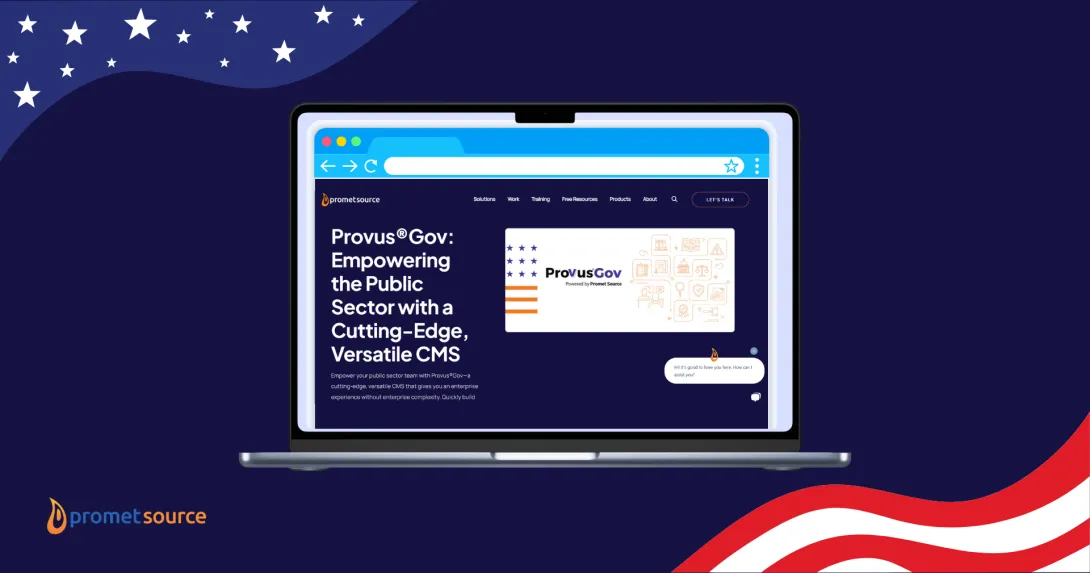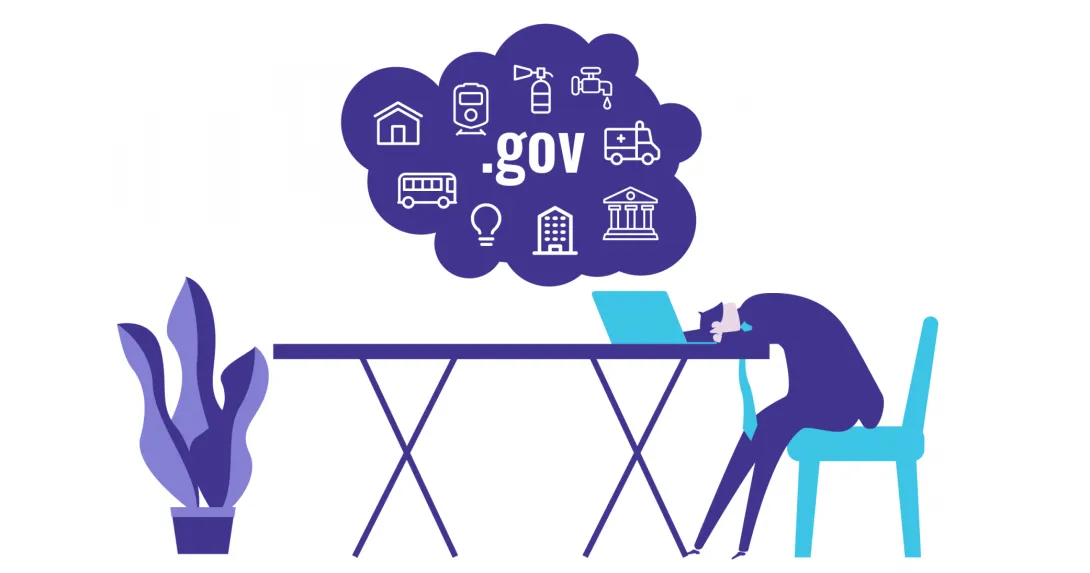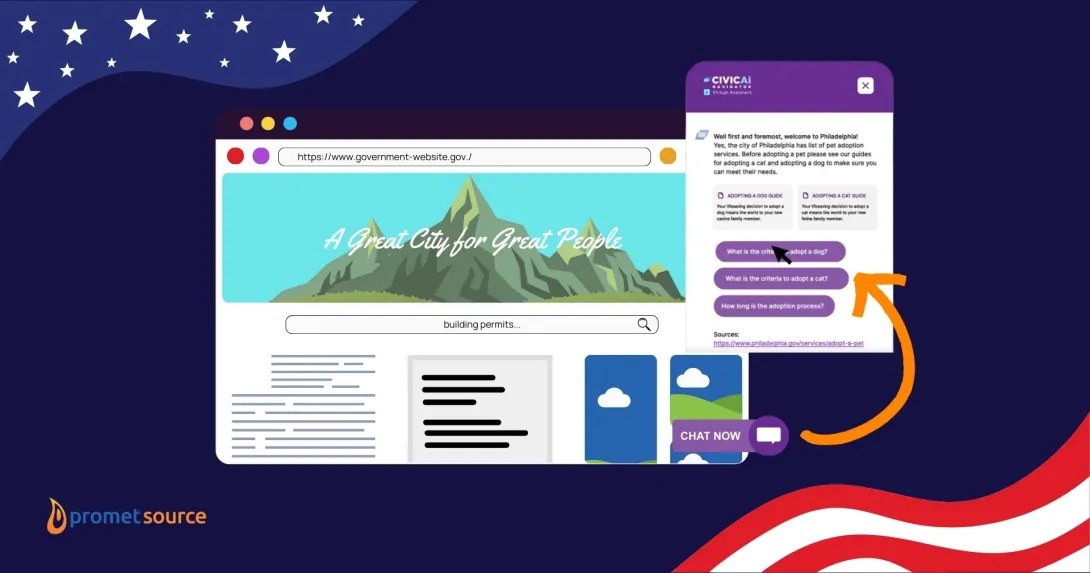Beyond Technical Features: The Organizational Impact Your RFP Missed

Table of Contents
Takeaway: Your CMS choice shapes far more than your website's features—it fundamentally determines how knowledge is distributed across your team, how your staff collaborates, and how resilient your digital presence is to personnel changes. While custom solutions create dangerous knowledge silos and proprietary platforms impose rigid constraints, component-based approaches like Provus®Gov create a balanced system that distributes expertise, empowers non-technical staff, and builds lasting digital capabilities across your organization.
Empower your team—book a free demo
The missing dimension in CMS decisions
When a local government agency evaluates custom CMS website development (to clarify, we're talking about typically homegrown solutions) versus pre-built options, the conversation typically revolves around features, functionality, and technical specifications.
But here's what gets overlooked: The CMS you choose shapes far more than your website—it fundamentally determines how your organization operates.
Our research into government CMS usage across the U.S. found that 67.2% of small cities (population under 100,000) use proprietary CMS solutions. And 96.4% of those proprietary CMS solutions are government-focused.
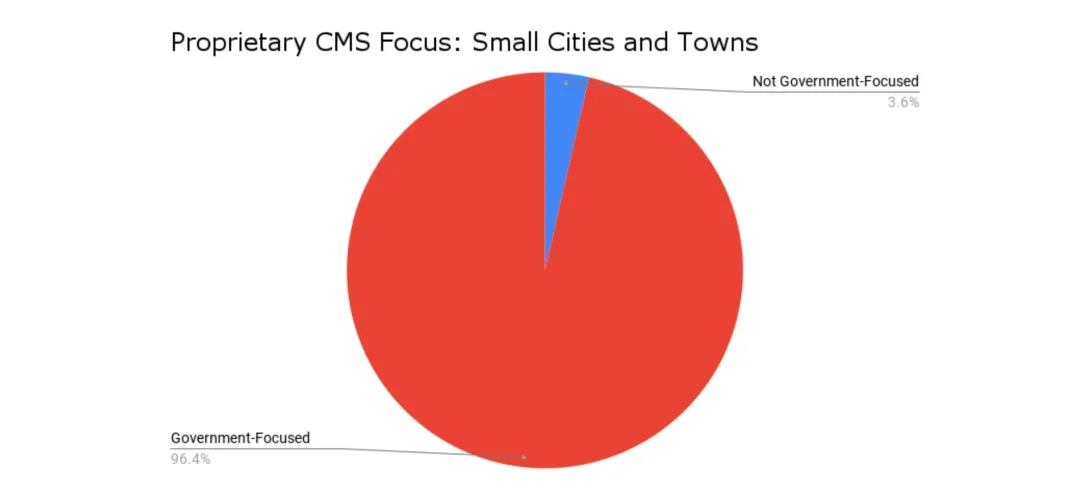
I completely understand the decision to go this route. When the goal is to set up your website fast and have all the nifty features it should have to properly get your work done, it’s easy to see why choosing a proprietary, government-focused CMS is the main option.
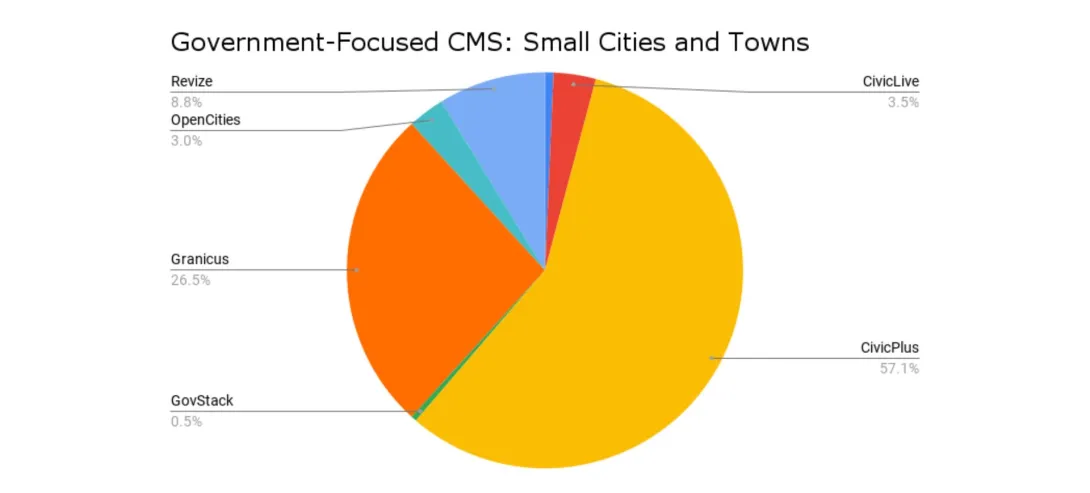
However, going with a ready-made government CMS seems like the safe choice until you need to do something that wasn't in the vendor's playbook—suddenly, you're stuck waiting for their development team to maybe add your feature request someday.
On the flip side, when a developer builds a custom system from scratch, they become the keeper of all knowledge about how it works. If (or when) they leave, your organization is left scrambling.
We’ve compared Provus®Gov with RFP requirements in a previous blog. This time, we'll examine CMS options through an organizational lens rather than just a technical one. We'll explore how different approaches—custom-built, pre-built proprietary, and component-based—create distinct organizational dynamics that ultimately determine your website's long-term success.
CMS options available for small governments
Let's break down the main options available to small government entities:
- Custom-built (homegrown) solutions are websites created from scratch, tailored specifically for your organization's needs. Think of it as having a custom suit made instead of buying off the rack.
- Pre-built proprietary platforms like CivicPlus, Granicus, and Revize offer government-specific templates and features in a ready-to-use package. These are like specialized uniforms designed specifically for government work.
- Component-based approaches give you the best of both worlds—pre-built pieces that can be mixed and matched to create something that feels custom but doesn't require building everything from zero.
Again, your CMS choice shapes far more than your website. It determines:
- How knowledge is distributed across your team (or concentrated in dangerous silos)
- How your staff collaborates on content creation and approval
- How resilient your digital presence is to personnel changes
- How your organization's digital capabilities evolve over time
Let’s start with custom-built solutions.
The organizational impact of custom-built CMS platforms
Custom CMS website development often begins with the best intentions—creating a solution perfectly tailored to your government's unique needs.
However, beyond the technical specifications and initial deployment, custom-built systems create distinct organizational patterns that can significantly affect how your team functions over time.
Let's examine these organizational impacts that rarely appear in technical requirements documents.
Knowledge concentration risk
Custom-built CMS platforms create a "knowledge concentration risk." It's pretty straightforward—everything about how your website works becomes tied to the expertise of one person or a small team.
Unlike more widely adopted solutions, a custom CMS requires specialized expertise that becomes increasingly difficult to maintain as staff changes occur.
When we talk to government web managers who've inherited custom-built systems, we hear the same story over and over:
Nobody really knows how this thing works anymore. The person who built it left years ago, and now we're afraid to touch it.
This is a real vulnerability for your organization. Many government teams end up in frustrating positions, unable to update or improve their websites because the original creator has moved on. Even small changes require bringing in expensive outside help who first have to figure out the custom system someone else built.
Governance challenges
Custom-built systems often create unexpected bottlenecks in your content workflows.
Let's say your communications team wants to publish an emergency alert. In a well-designed system, they should be able to do that quickly. But in many custom systems, they'll need to go through a technical gatekeeper who understands how to implement it.
These technical bottlenecks undermine your content governance model. Suddenly, your carefully designed approval workflows hit a technical roadblock because only one or two people understand how to implement certain types of content.
Over time, these bottlenecks can reshape how your entire organization makes decisions about web content, creating frustrating workarounds and dependencies that weren't part of your original plan.
Staff turnover vulnerability
When key development staff leave, custom CMS systems become especially vulnerable. Unlike widely used platforms where replacement talent is readily available, custom systems require specialized knowledge that's hard to replace.
This vulnerability extends beyond your internal staff. If you've worked with an agency to build your custom CMS, changing vendors can be particularly painful.
New vendors are often reluctant to take on maintenance of a custom system they didn't build. And when they do, they typically recommend rebuilding from scratch rather than trying to decipher someone else's custom code.
This creates a difficult catch-22: You're locked into your original development partner, but if that relationship ends, you face starting over from square one.
Constant maintenance burden
Custom solutions also create a constant maintenance burden that falls squarely on your already-stretched IT resources.
Security updates, browser compatibility issues, and new feature requests—they all require ongoing attention from technical staff with specialized knowledge.
For small government entities with limited IT resources (and let's be honest, who doesn't have limited resources?), this maintenance burden often leads to neglect. Updates get postponed, security vulnerabilities pile up, and the website gradually becomes outdated because nobody has the bandwidth to keep it current.
The innovation gap
Perhaps most concerning is the innovation gap that emerges over time. As web technologies evolve and citizen expectations change, custom solutions become increasingly difficult to upgrade.
Each new feature requires custom development, creating a constant game of catch-up that drains resources and frustrates staff.
So, while a custom solution might initially seem like the path to ultimate flexibility and control, the organizational reality is often quite different.
Technical dependencies concentrate knowledge, create maintenance burdens, and ultimately make it harder—not easier—for your organization to innovate and keep pace with evolving citizen needs.
The organizational impact of pre-built proprietary platforms
While custom-built solutions create knowledge concentration risks, pre-built proprietary platforms present a different set of organizational challenges.
These government-specific CMS solutions may solve immediate technical needs, but they often create dependencies and constraints that reshape how your entire organization approaches digital content.
Vendor dependency
Proprietary government-specific platforms solve many technical problems right out of the box, but they create a different kind of organizational challenge: Vendor dependency.
Your organization's ability to improve its digital presence becomes completely tied to your vendor's development roadmap and pricing decisions.
Need a specific feature that would make a real difference for your citizens? You'll have to wait until enough other customers request it too—or pay a premium for customization.
This dependency shows up in surprising ways across your organization:
- Content editors start creating workarounds for platform limitations
- IT staff find themselves spending more time managing vendor relationships than solving technical problems
- Leadership gets frustrated when digital initiatives stall because "the platform doesn't support that"
Over time, this dependency creates a form of institutional inertia. Once you've invested time and resources in a proprietary platform, the cost of switching becomes so high that you're effectively locked in—regardless of how well the platform meets your evolving needs.
Operational constraints
We've seen this scenario play out countless times: A government agency selects a proprietary CMS, and six months later, they've restructured their entire content workflow to match what the platform expects.
If you’ve felt at least once that the tail (your CMS) is wagging the dog (your department), then you know what I mean.
Small government digital capabilities are often constrained by proprietary platforms that embed specific assumptions about content workflows. When these assumptions don't match your organization's actual workflows, you face a difficult choice: Change your operations or fight the platform.
Most teams end up adapting to the platform's expectations, often creating inefficiencies that weren't there before. Approvals that once took hours now take days. Simple content updates require multiple people across departments.
What was supposed to make things easier ends up making things more complicated.
Limited digital capability growth
Perhaps the most subtle—but significant—impact is how proprietary platforms limit your organization's opportunity to develop genuine digital capabilities.
When staff can only operate within the confines of a vendor's system, using their specific terminology and predefined processes, they don't develop the broader digital literacy and skills that would enable more strategic approaches to online engagement.
Simply put, your content team may know how to use your CMS, but they don't understand the fundamentals of your actual strategy. They’ve learned how to do things the vendor’s way but not the why behind it.
This limitation creates a persistent skills gap. Your team becomes adept at using one specific system but lacks the transferable knowledge to evaluate other approaches or innovate beyond the platform's boundaries.
The organization becomes permanently dependent on the vendor, not just for technology but for digital expertise itself.
Organizational agility issues
People interact with sophisticated digital services every day, from online shopping stores to banking apps, and they expect their government websites to keep pace.
Proprietary platforms often make it difficult to respond quickly to these changing expectations:
- New capabilities move slowly through vendor development pipelines
- Pricing structures may discourage experimentation
- Rigid templates limit creative responses to emerging needs
We saw this clearly during the COVID-19 pandemic. Many small cities using proprietary platforms struggled to quickly create the responsive, information-rich pages that citizens needed. We’ve heard stories of webmasters building completely separate websites for their COVID response because their proprietary CMS couldn't be adapted quickly enough for the emergency.
This lack of agility doesn't just affect website functionality. When rapid adaptation is consistently difficult, teams stop suggesting innovative approaches altogether. The organization develops a "that's not possible with our system" mindset that stifles growth.
While proprietary platforms offer valuable out-of-the-box functionality, their organizational impact often includes vendor dependency, operational rigidity, limited digital capability development, and reduced agility—all factors that can undermine your government's success in the long term.
Component-based approaches: The organizational middle path
Between fully custom and strictly proprietary approaches lie component-based solutions. These approaches, like Drupal with Provus®Gov, use pre-built components within a flexible framework, creating a distinctly different organizational dynamic.
Distributed knowledge architecture
Component-based solutions create what we call a "distributed knowledge architecture." Instead of concentrating technical knowledge in a few specialists or locking it away with a vendor, these systems distribute expertise across your entire team.
Here's how it typically works in practice:
- Content editors understand their specific components and how to use them effectively
- IT staff comprehend the technical foundation and can troubleshoot when needed
- Department heads grasp how the structure supports their content needs
- Leadership understands the overall system well enough to make strategic decisions
This distribution of knowledge makes your organization significantly more resilient to staff changes. When someone leaves, they don't take all the system knowledge with them. The distributed understanding means others can step in while you find a replacement.
Balanced standardization and flexibility
Component-based solutions strike a healthy balance between standardization and flexibility. Pre-built components ensure visual consistency and reduce technical debt, while the ability to assemble and configure these components allows for customization where it matters most.
This balance changes how teams approach challenges with their website. Rather than feeling constrained by technology, teams can focus on solving specific problems using proven components. The conversation shifts from "Can we do this?" to "What's the best way to do this?"
Imagine not having to check with a vendor to see if something was possible. Your content team can just build it themselves using components, then just ask IT if some refinement is needed.
This balance creates a more collaborative, solution-focused culture where technical and content teams work together rather than creating dependencies and bottlenecks.
Growing beyond the platform through digital capability building
Perhaps most importantly, component-based solutions like Provus®Gov actively build digital capabilities across your organization. Unlike custom or proprietary options, these approaches help staff develop transferable skills that extend beyond the specific CMS.
When content editors work with Provus®Gov's component system, they're not just learning which buttons to click—they're internalizing core digital communication principles through practical application.
The component architecture teaches content hierarchy and information architecture as editors arrange page elements
The visual editing interface demonstrates responsive design principles as editors have to consider how the content adapts to different screen sizes
Content governance workflows reinforce publishing standards and approval processes that apply across digital channels
This contextualized learning makes digital best practices tangible rather than theoretical, creating an understanding of effective digital communication that remains valuable even if your technology stack changes in the future.
Organizational resilience and adaptability
Component-based systems are inherently more adaptable to organizational change. As departments reorganize, priorities shift, or new service models emerge, the system can evolve alongside these changes without major rebuilds or vendor negotiations.
This adaptability extends to staff roles as well. New team members can be onboarded more quickly because they can learn specific components relevant to their responsibilities rather than having to understand an entire custom system or proprietary platform.
The result is an organization that can respond more effectively to changing citizen needs, evolving best practices, and emerging technologies – creating a more resilient and forward-looking digital presence.
While no approach is perfect for every situation, component-based solutions like Provus®Gov offer a middle path that addresses many of the organizational challenges inherent in both custom and proprietary approaches.
City of Rochester's organizational transformation through Provus®Gov
The City of Rochester's website redesign illustrates perfectly how CMS choice impacts organizational dynamics. Before implementing Provus®Gov, Rochester faced challenges familiar to many government entities.
The challenge: Fragmented teams and technical dependencies
Rochester's digital presence suffered from years of technological and organizational challenges. Their website was built on outdated technology with significant navigation and design limitations.
More problematically, their departments operated in silos, resulting in:
- Incomplete, scattered content and inconsistent messaging
- Limited accessibility for users with disabilities
- Widespread resident dissatisfaction with the site's usability
- Difficulty in locating critical information
The solution: Implementing Provus®Gov's component-based approach
Rochester chose Provus®Gov as the foundation for their new website, leveraging its component-based architecture to address both their technical and organizational challenges.
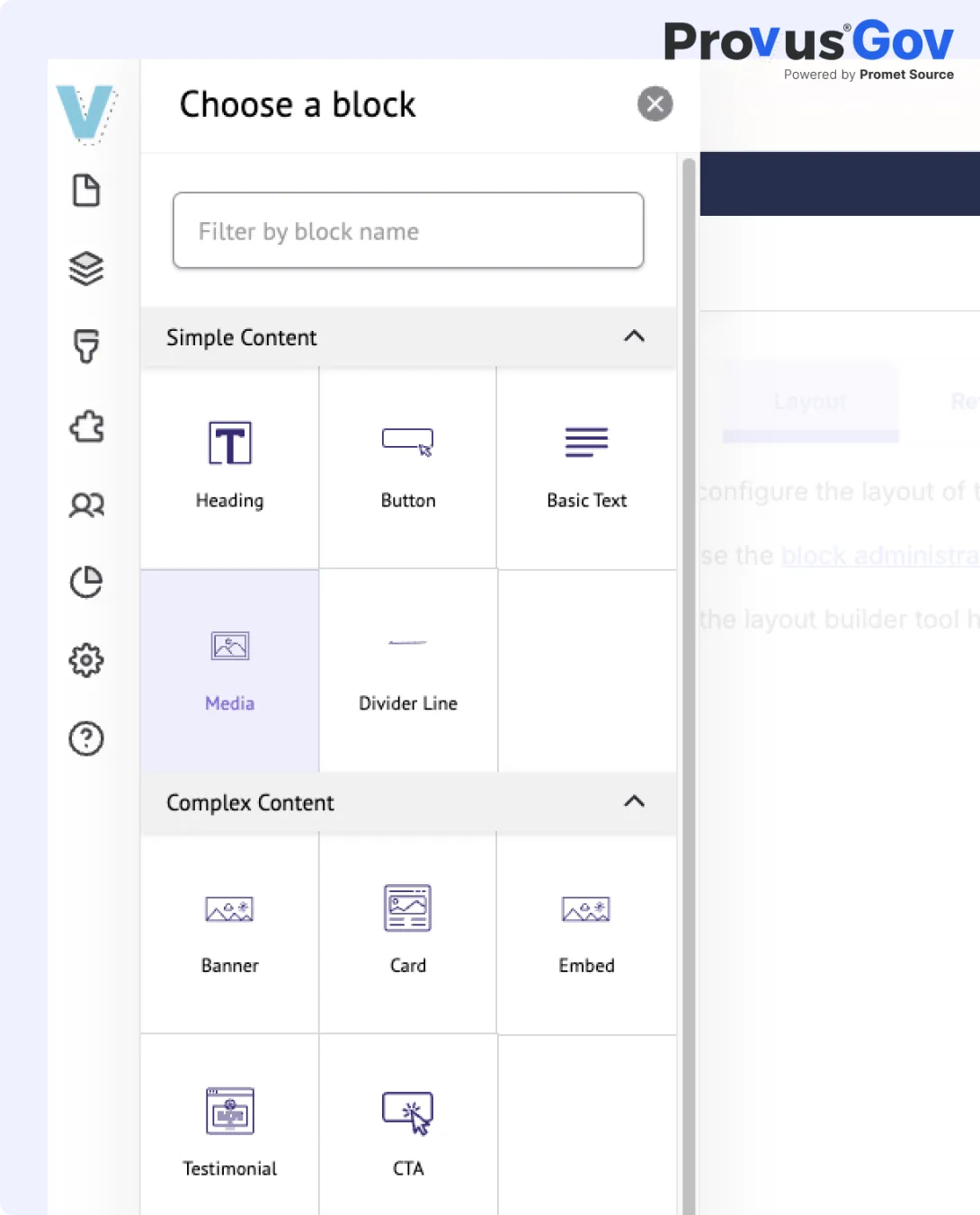
The implementation involved:
- Adopting a user-centered design approach
- Conducting discovery workshops and stakeholder interviews
- Performing usability testing to gain insights into residents' needs
- Prioritizing accessibility to achieve full compliance with WCAG
- Implementing enhanced navigation and search capabilities using reorganized information architecture
How roles and processes evolved
The component-based approach of Provus®Gov fundamentally changed how Rochester managed its digital presence. The transition created a distributed knowledge architecture where expertise was spread across teams rather than concentrated with a few technical specialists.
Provus®Gov's dynamic design balanced Rochester's heritage with a forward-looking aesthetic, featuring high-quality visuals, interactive components, and a more efficient content management system while accommodating current needs and allowing for future enhancements.
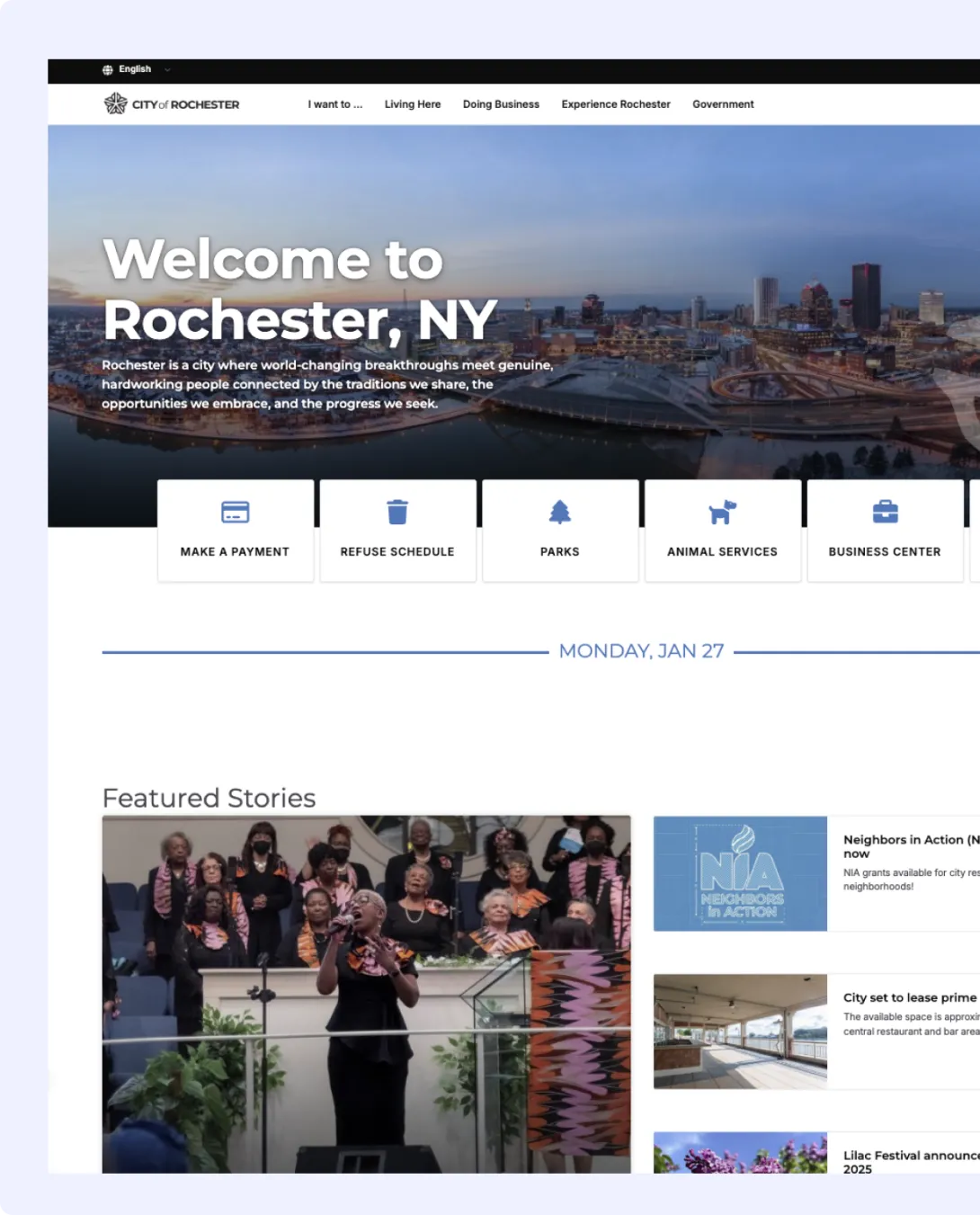
Real organizational impact
According to Ted Capuano, Assistant Communications Director for the City of Rochester:
The new website is so easy to use, we've nearly tripled the amount of internal website coordinators and contributors since work on the new site started; our colleagues are excited and energized by it because it's easy to use and navigate.
This dramatic increase in content contributors represents a fundamental shift in the city's digital operations. Instead of knowledge being concentrated with a few technical specialists, it's now distributed across departments, creating a more sustainable operating model for content management.
Key lessons for other cities
Rochester's experience demonstrates how a component-based CMS can transform not just a website but an organization's entire approach to digital communication.
Their success highlights the importance of:
- Distributing knowledge and capabilities across departments
- Empowering non-technical staff with intuitive content management tools
- Balancing standardization with flexibility through component-based design
- Building organizational resilience to staff changes and evolving needs
![[Webinar] Transforming City Websites Featuring: City of Rochester](/sites/default/files/styles/wide/public/2024-10/webinar-cor-header.jpg.webp?itok=yWfJHUP_)
Evaluating your CMS options through an organizational lens
Our analysis of 35 website RFPs revealed that only 51% considered knowledge transfer risks, while just 26% explicitly addressed how their CMS choice would affect staff capabilities.
This oversight explains why many government websites become increasingly difficult to maintain over time, regardless of their initial technical quality.
This is understandable since technical specifications are tangible and easy to compare in a spreadsheet. Organizational impacts are harder to measure and often become apparent only after implementation—when it's too late to change course.
A quick note: You can easily solve the oversight by using a reliable RFP template. You can download ours for free.
To make a more holistic evaluation, I suggest covering these five key organizational dimensions:
- Knowledge distribution assessment
- Governance model compatibility
- Staff capability development
- Operational flexibility
- Long-term sustainability planning
Knowledge distribution assessment: Who will understand how your website works?
- Will knowledge of how the system works be concentrated with a few technical specialists or distributed across your team?
- If your webmaster or key technical person left tomorrow, how many people would understand how to maintain and update the site?
- Does the CMS require specialized technical knowledge that might be difficult to replace if staff members leave?
Governance model compatibility: Does the CMS support your decision-making processes?
- Does the platform's workflow align with your organization's approval processes?
- Can you establish role-based permissions that match your organizational structure?
- Do content approval workflows avoid creating technical bottlenecks?
Staff capability development: Will the CMS help build in-house skills?
- Does the platform help staff develop transferable digital skills or just system-specific knowledge?
- Will team members learn fundamental principles of digital communication or just how to navigate a specific interface?
- Does the CMS empower non-technical staff to become more digitally capable over time?
Operational flexibility: Can the CMS adapt to evolving organizational needs?
- How easily can the system accommodate departmental reorganizations or new service models?
- Can you quickly respond to emerging citizen needs or emergency situations without technical bottlenecks?
- Is the system flexible enough to incorporate new content types or features as your digital strategy evolves?
Long-term sustainability planning: How will the CMS perform through staff changes?
- How dependent will you be on specific individuals or vendors for ongoing maintenance?
- What happens if your primary technical support person or vendor relationship changes?
- How easily can new staff members be onboarded to use and understand the system?
How Provus®Gov answers the evaluation questions
After examining the organizational challenges of both custom-built and proprietary CMS solutions, let's see how Provus®Gov addresses the key organizational questions we identified for evaluating CMS options.
| Assessment Area | Question | Provus®Gov's Approach |
|---|---|---|
| Knowledge Distribution Assessment | Will knowledge of how the system works be concentrated with a few technical specialists or distributed across your team? | Provus®Gov is designed with an intuitive drag-and-drop interface, enabling non-technical staff to manage content effectively. This approach ensures that system knowledge is distributed across the team, reducing reliance on a few technical specialists. |
| If your webmaster or key technical person left tomorrow, how many people would understand how to maintain and update the site? | The user-friendly design of Provus®Gov allows multiple team members, regardless of technical expertise, to maintain and update the site. This reduces the risk associated with the departure of key technical personnel. | |
| Does the CMS require specialized technical knowledge that might be difficult to replace if staff members leave? | Built on Drupal, Provus®Gov simplifies website creation and management, minimizing the need for specialized technical knowledge. This facilitates easier staff transitions and reduces dependency on specific technical skills. | |
| Governance Model Compatibility | Does the platform's workflow align with your organization's approval processes? | Provus®Gov allows for the development of customized content governance strategies, including defined roles and workflows that can align with organizational approval processes. |
| Can you establish role-based permissions that match your organizational structure? | The platform supports varying permission levels, enabling the establishment of role-based access that mirrors the organizational hierarchy. | |
| Do content approval workflows avoid creating technical bottlenecks? | Provus®Gov reduces technical bottlenecks and enhances efficiency by streamlining content creation, editing, and approval processes. | |
| Staff Capability Development | Does the platform help staff develop transferable digital skills or just system-specific knowledge? | Provus®Gov's user-friendly tools enable staff to develop transferable digital skills applicable beyond the specific system. The component-based design system fosters understanding of general web content management principles. |
| Will team members learn fundamental principles of digital communication or just how to navigate a specific interface? | The platform emphasizes a component-based design approach, encouraging users to understand content structuring, user experience, and accessibility. This design philosophy promotes learning of core digital communication principles rather than just platform navigation. | |
| Does the CMS empower non-technical staff to become more digitally capable over time? | Yes, Provus®Gov is designed with non-technical users in mind. Features like in-context editing, reusable content blocks, and customizable templates allow staff without coding experience to manage and update website content confidently, enhancing their digital proficiency over time. | |
| Operational Flexibility | How easily can the system accommodate departmental reorganizations or new service models? | Provus®Gov's flexible architecture allows for easy adjustments to site structure and content, accommodating organizational changes without significant technical overhead. |
| Can you quickly respond to emerging citizen needs or emergency situations without technical bottlenecks? | The platform enables rapid content updates and page creation, facilitating swift responses to emerging situations. | |
| Is the system flexible enough to incorporate new content types or features as your digital strategy evolves? | Built on Drupal, Provus®Gov offers scalability and flexibility to integrate new content types and features as needed, supporting the evolution of your digital strategy. | |
| Long-Term Sustainability Planning | How dependent will you be on specific individuals or vendors for ongoing maintenance? | As an open-source solution, Provus®Gov reduces dependency on specific vendors, offering flexibility in choosing support providers and ensuring long-term sustainability. |
| What happens if your primary technical support person or vendor relationship changes? | The widespread use of Drupal ensures a large pool of professionals familiar with the platform, easing transitions between support personnel or vendors. | |
| How easily can new staff members be onboarded to use and understand the system? | Provus®Gov's intuitive interface and comprehensive documentation facilitate quick onboarding of new staff members, reducing training time and accelerating productivity. |
Stop struggling with knowledge silos and vendor lock-in
Choosing a CMS is a strategic decision that can significantly shape your organization's digital future.
Whether you're navigating the challenges of custom-built systems, feeling constrained by proprietary platforms, or simply seeking a more agile, empowering approach, the right choice can unlock greater organizational resilience, operational efficiency, and digital innovation.
Provus®Gov uniquely combines the power and flexibility of Drupal with the ease-of-use and intuitive controls your team needs to thrive. You can distribute knowledge across your team, eliminate vendor lock-in, and create pathways for ongoing digital capability growth in one go through this powerful CMS.
Ready to break free from both the knowledge concentration risks of custom solutions and the rigid constraints of proprietary platforms? Schedule your free Provus®Gov demo today and discover how a component-based approach can transform not just your website but your entire organization's digital capabilities.
Get our newsletter
Get weekly Drupal and AI technology advancement news, pro tips, ideas, insights, and more.

